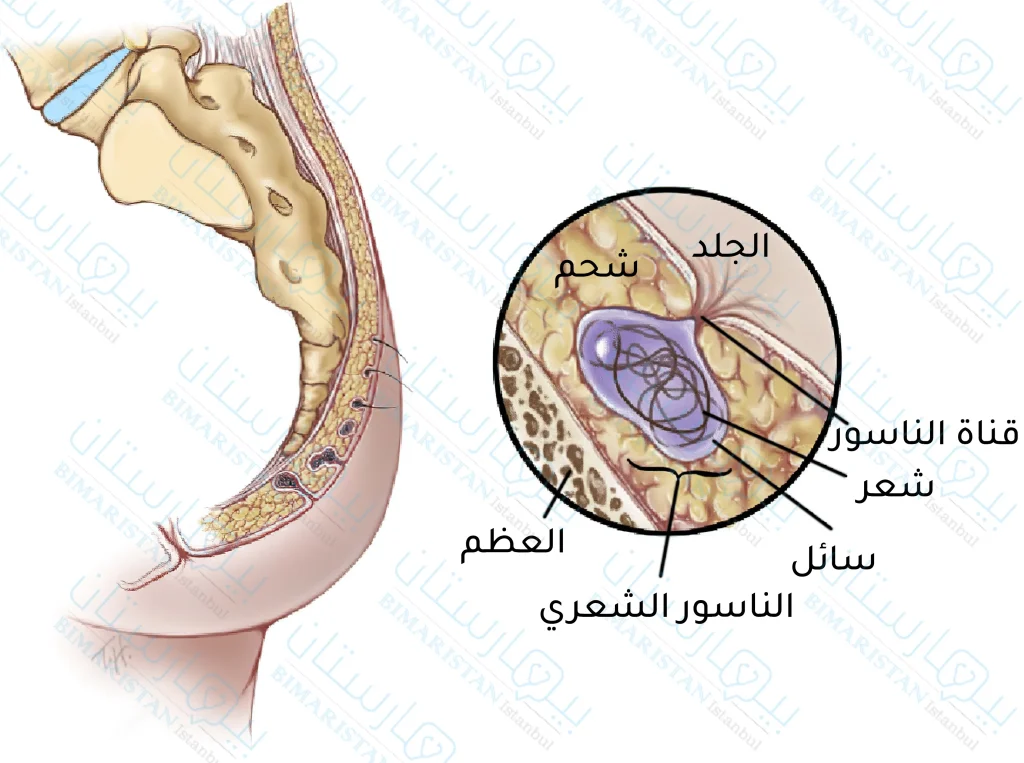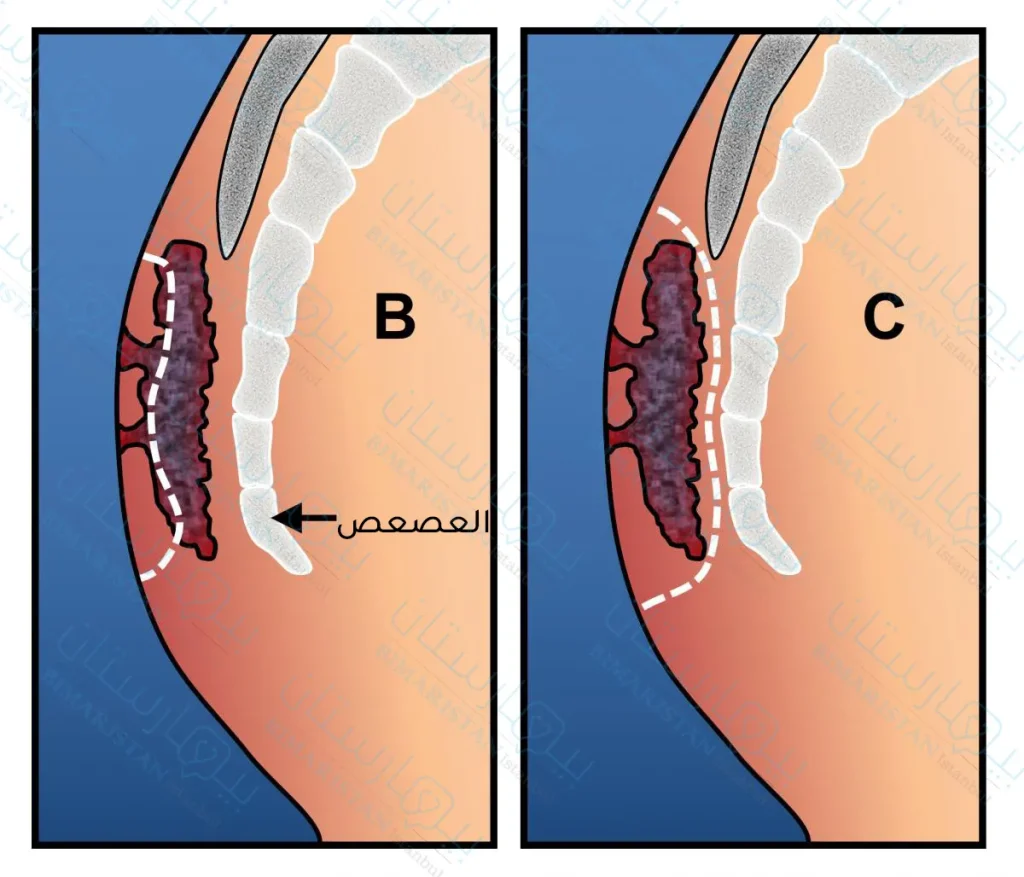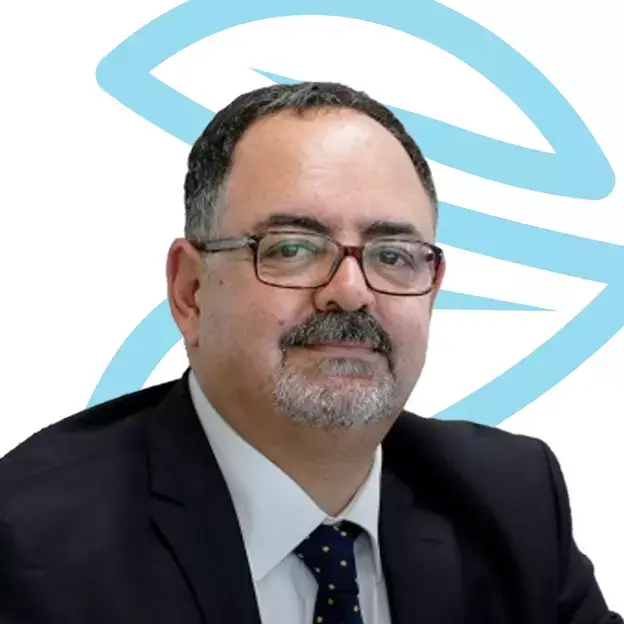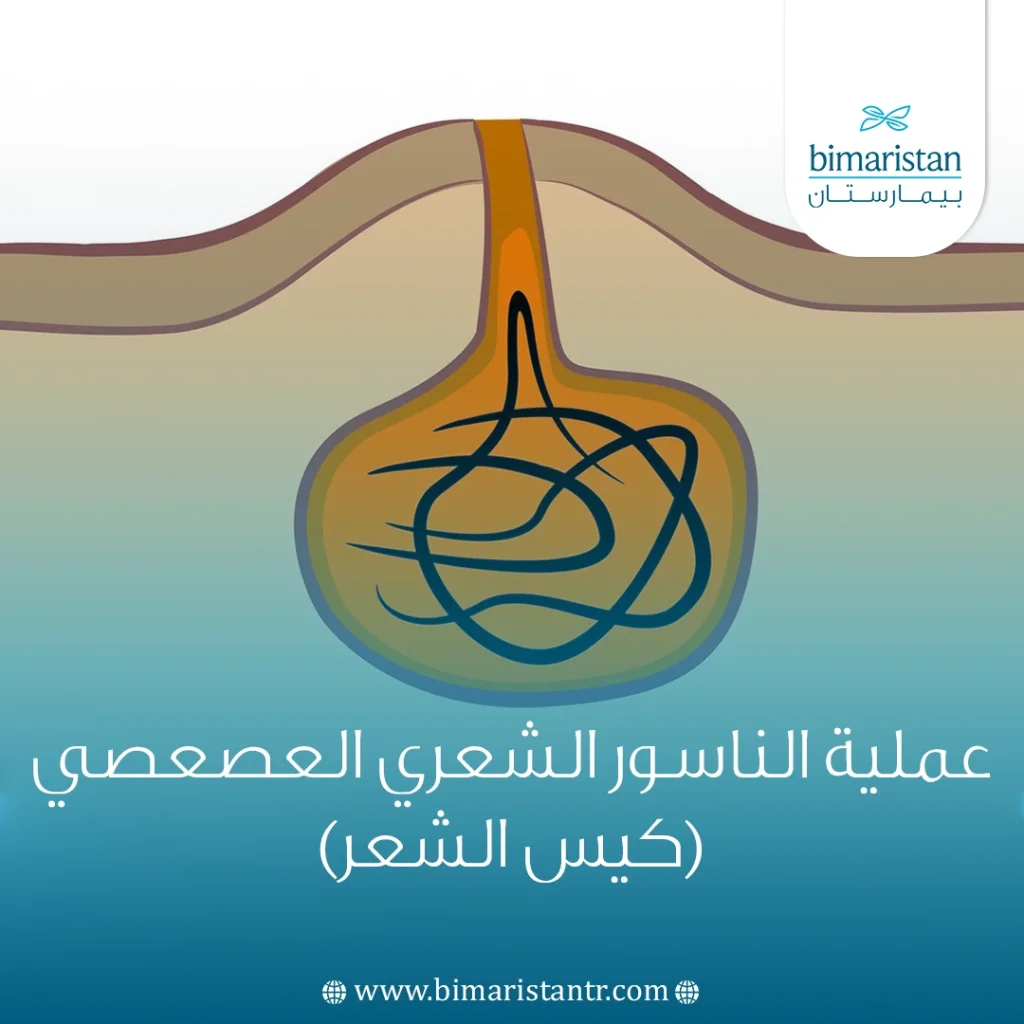يظهر الناسور الشعري عند اليفع بشكل خاص وهو غالباُ ما يميل للنكس، لذلك يحتاج علاجه إلى أيدي ذات كفاءة عالية وخبرة لإجراء عملية الناسور الشعري وهو ما يوفره أطباء تركيا.
ما هو الناسور الشعري العصعصي (كيس الشعر)؟
يسمى بالناسور العصعصي (الناسور الشرجي) أو الكيسة الشعرية Pilonidal Cyst وهو عبارة عن كيس متوضع في الجلد يحتوي الشعر و بقايا جلدية يظهر في قاعدة عظم العصعص في قمة الشق بين الأرداف (الشرجي).
كان الأطباء يعتقدون أن الإصابة ب ناسور الشعر العصعصعي حالة خلقية إلا أنه ومع مرور الزمن اكتشف أنه ينشأ نتيجة انقلاب بعض الشعر الموجود حول النسيج الرخو واختراقه الجلد، حيث يتعامل الجسم مع هذا الشعر على أنه جسم غريب مما يؤدي إلى تشكيل كيس الشّعر (الناسور العصعصي) وحدوث التسمك الجلدي الملاحظ.

يصيب الناسور الشعري العصعصي عادةً الرجال ب 2.2 مرة أكثر من النساء وهو غالباً ما يظهر قبل سن ال 40 (20-30).
يمكن ل الناسور الشعري العصعصي أن يصاب بالإنتان ويصبح مؤلماً للغاية وقد يصل لمرحلة شديدة لا يستجيب فيها للعلاج بالصادات أو العلاجات البدئية الأخرى.
المرضى عاليي الخطورة هم من يجلسون طويلاً من دون حركة كسائقي الشاحنات، عمال المكاتب، الدراجون…
يمكن لبعض المرضى أن يطوروا ناسور الشعر العصعصي في أماكن مختلفة مثل أصابع اليد عند الحلاقين ومربي الأغنام والبقر.
اعراض الناسور الشعري العصعصي
إذا لم يصب الناسور بالإنتان ففي الغالب لا يوجد أعراض أو قد يوجد انزعاج بسيط عند الجلوس على نفس مكان الناسور أو في حال التهاب الناسور، أما في حال الإنتان يتشكل ما يعرف بـ الخراج الشعري Pilonidal Abscess، ويتظاهر خراج الناسور العصعصي بالأعراض الآتية:
- احمرار في الجلد
- الألم
- تسرب القيح من الناسور
- رائحة كريهة نتيجة القيح
- حمى
يجب الإسراع في معالجة الناسور الشعري العصعصي وإلا فإن الحالة ستسوء أو حتى تتطور (ولو بنسبة ضئيلة) إلى سرطان حرشفي الخلايا SCC.
التحضيرات قبل عملية الناسور الشعري
سيخضع المرضى لفحص جسدي من قبل الجراح لمناقشة الأعراض وتحديد طريقة العلاج الجراحي المناسبة، وتختلف التحضيرات باختلاف نوع عمليّة الناسور العصعصي المجراة، عادة لا تكون هناك حاجة لفحوصات الدم الروتينية ولكن قد يتم طلبها قبل الجراحة بناءً على عمر المريض ووجود أي مشاكل طبية لديه، وقد يُطلب من المرضى التوقف عن تناول بعض الأدوية قبل الجراحة.
وعادةً ما يطلب الطبيب من المريض التوقف عن الأكل قبل 8 ساعات من العملية
ما هي أنواع عملية الناسور الشعري المنتشرة في تركيا؟
هنالك عمليتان شائعتان لعلاج الناسور العصعصي (كيس الشعر) في تركيا إلا أنه يتم دراسة طرق أخرى جراحية كانت أم لا، حيث يدرس مدى فعاليتها في العلاج بدون اختلاطات ومنع نكس الناسور العصعصي، وقد ارتفعت في تركيا في الآونة الأخيرة نسبة الشفاء من الناسور الشعري بسبب تطور الطرق الجراحية لديها وكفاءة الأطباء.
عملية شق ونزح الناسور العصعصي
وهي عملية صغيرة تجرى داخل عيادة الطبيب تحت التخدير الموضعي (التخدير الموضعي كافٍ هنا) فقط، ويُنصح بها عند المرضى الذين حدث لديهم الناسور العصعصي لأول مرة والإنتان فيه بسيط غالباً.
يقوم الدكتور بإجراء شق في الناسور العصعصي والذي يجرى تصريف السائل والقيح الموجود في الناسور عبره، ثم يقوم بعدها ب وضع القطن والشاش في الجرح ويتركه مفتوحا ريثما يضمر الناسور العصعصي ويزول (يجب تغيير المدك من الشاشي أو القطن باستمرار) وهذه تسمى طريقة الجرح المفتوح، وهي ذات نتائج أفضل من حيث منع انتكاس الناسور العصعصي.
يمكن للطبيب أن يقوم ب إغلاق الجرح وخياطته وهذه الطريقة هي الجرح المغلق، إلا أن النكس في هذه الطريقة مرتفع.
ينصح بعد هذه العملية ان يقوم المريض بإزالة الشعر إما بالحلاقة أو بالليزر حول منطقة الكيسة ( أسفل الظهر) للتقليل من نسبة النكس.
استئصال الناسور الشعري العصعصي (الكيس الشعري)
في حال وجود مشاكل لدى المريض المجرى له شق وتصريف الناسور العصعصي في وقت سابق، أو أن الإنتان سيء جداً أو أن المريض لديه عدة نواسير شعرية مترافقة بجيوب شعرية، تصبح عندها عملية الناسور الشعري ضرورة، حيث نحتاج إلى علاج أنجع و إجراء عملية أكبر surgery وهي عملية استئصال الناسور الشعري العصعصي.
جراحة الناسور العصعصي هي عملية تتم خارج العيادة تجرى في المشفى في غرفة العمليات، حيث تتم عملية الناسور العصعصي على يد جراح مختص، وغالباً ما يبقى المريض لليلة واحدة في المشفى، حيث يخدّر المريض تخدير عام أو تخديراً ناحيّاً للقسم السفلي من الجسم (التخدير العام أفضل)، وبعد ذلك يقوم الجراح ب اجراء شق جراحي ويقوم باستئصال كمية محددة من النسيج (بناءً على عمق الكيسة وعدد النواسير) حول الناسور ثم يقوم ب إزالة الناسور نفسه وكما في العملية السابقة يمكن أن نلجأ للطريقة الجراحية المفتوحة أو المغلقة.

يجب العناية بالجرح بشكل كبير حتى يلتئم وإلا سيعاود الإنتان بعد أيام وسينكس الناسور، حيث يجب اتباع تعليمات الطبيب أو الممرضة بشكل كامل خوفاً من حدوث ما ذكرنا.
عمليات أخرى
يتم حالياً دراسة طرق أخرى أقل توغلاً من الطرق السابقة لعلاج الناسور الشعري وقد أظهرت الدراسات نجاعة هذه الطرق في علاج الناسور الشعري (كيس الشعر) كـ (عملية استئصال الجيب الشعري المساعد بالفيديو أو عملية استئصال الجيب الشعري بالمنظار).
مضاعفات عملية الناسور الشعري
تعد عملية الناسور الشعري بطرقها المذكورة عملية آمنة، حيث لا نكاد نرى اختلاطات لعملية الناسور إلا ربما الألم وهذا أمر طبيعي ويختلف لاختلاف الحالات إذ لا يخلو الأمر من بعض الاختلاطات.
يمكن أن تظهر اختلاطات أخرى نتيجة عودة الإنتان في الناسور وعدم العناية الجيدة بالجرح وإن أعراض عودة الإنتان في الناسور هي نفسها المذكورة سابقاً في المقال.
إن عملية الناسور الشعري شديدة النكس في حال عدم تدبيرها بشكل صحيح، وقد نحتاج إلى عدة عمليات للتخلص من الناسور الشعري بشكل كامل.
علاج الناسور العصعصي في البيت
إن العلاج المنزلي هو أمر نسبي، فما يعمل عند أحد المرضى ربما يؤدي إلى مضاعفات خطيرة عند مريض آخر، لذلك ينصح مركز بيمارستان بعدم أخذ الوصفات من الانترنت بشكل عشوائي وبدون استشارة طبية.
يمكن أن يعالج الناسور العصعصي في المنزل عبر عدة طرق تقليدية غير جراحية، لكن تبقى هذه المعالجة عرضية وربما لا تكون شافية بشكل كامل أو أنها لا تؤدي إلى اختفاء الأعراض بشكل كامل، كما يمكن لبعض الوصفات أن تزيد من الأعراض عوضاً عن أن تخففها، كما أن نجاح طريقة علاجية عند شخص ما لا يعني بالضرورة نجاح هذه الطريقة عند مريض آخر أو عند كل المرضى.
ومن هذه الطرق العلاجية المنزلية نذكر:
- الكمادات الساخنة: يمكن أن يساعد استخدام الكمادات الساخنة عدة مرات في اليوم في تهدئة الالتهاب، حيث تتيح الحرارة المنبعثة من الكمادة تصريف القيح الكيسة الشعرية (الناسور العصعصي) وبالتالي تخفيف الألم.
- دهن Aloe Vera: وهو دهن يحوي على مضادات التهاب ومضاد بكتيري يمكن أن يساعد على التخفيف من الأعراض.
- كريمات مضادة للالتهاب معتمدة عالمياً.
- حلاقة الشعر في منطقة الناسور الشعري.
- تنظيف منطقة الناسور باستمرار.
التعافي بعد عملية الناسور الشعري
تختلف مدة التعافي من العملية باختلاف نوع العملية وطريقتها (أي إذا ترك الجرح مفتوح أم أُغلق) وغالباً تتراوح عملية الشفاء حوالي شهر أو شهرين (تكون فترة الشفاء أطول في حالة الجرح المفتوح).
يمكن للطبيب أن يصف أدوية مخففة للألم أو بعض الحمامات الخاصة للجرح، وقد يصف بعض الصادات الحيوية للتأكد من شفاء الإنتان وعدم معاودته.
معظم المرضى يمكنهم العودة إلى عملهم في اليوم التالي للعملية إلا أنه يجب تجنب بعض الأنشطة ريثما تشفى الحالة بشكل كامل كما يجب اتباع بعض التعليمات و نصائح الطبيب لضمان عدم النكس ومن هذه الأنشطة والتعليمات:
- تجنب القيام بأعمال مجهدة.
- الابتعاد الجلوس لفترات طويلة.
- تجنب ركوب الدراجة.
- خسارة الوزن عند المرضى البدينين.
- حلق شعر المنطقة باستمرار إما بالحلاقة أو استخدام الليزر وتنظيف المنطقة باستمرار وخاصة فتحة الجرح.
المصادر:

